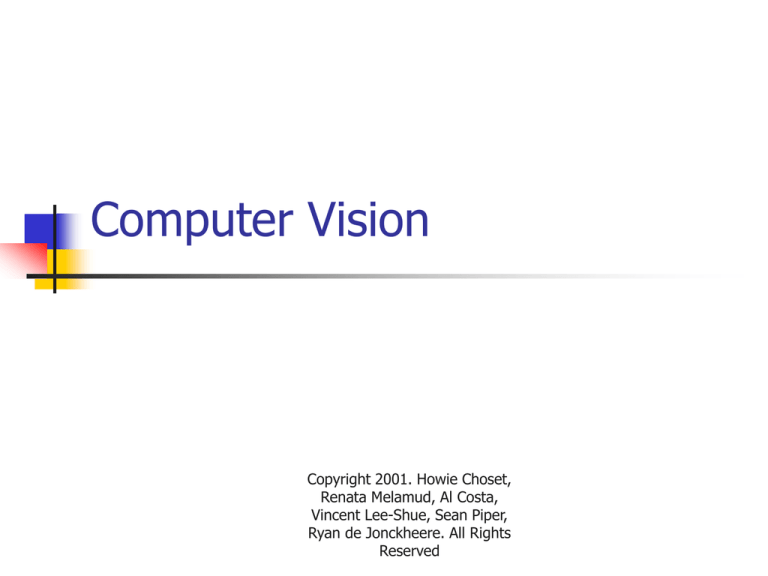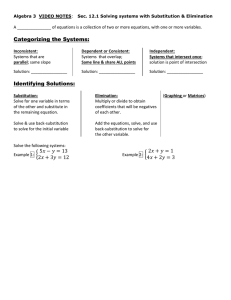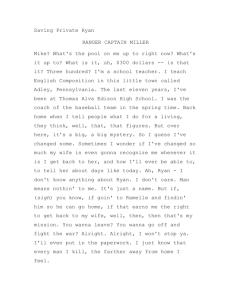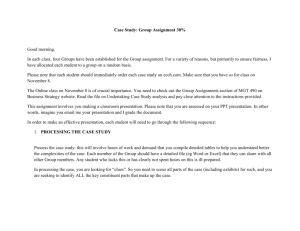
Computer Vision
Copyright 2001. Howie Choset,
Renata Melamud, Al Costa,
Vincent Lee-Shue, Sean Piper,
Ryan de Jonckheere. All Rights
Reserved
Optics
Focal length
Object
Length f of projection through lens on
image plane
Inversion
Projection on image plane is inverted
Image plane
f
Copyright 2001. Howie Choset, Renata Melamud, Al Costa, Vincent Lee-Shue, Sean Piper, Ryan de Jonckheere. All Rights Reserved
Projection on the image plane
Size of an image on the image plane is inversely proportional to
the distance from the focal point
Image plane
h
d
f
Focal point
h
h’
h h
d
f
By conceptually moving the image plane, we can eliminate the
negative sign
d
Image plane
h’
f
Focal point
h h
d f
Copyright 2001. Howie Choset, Renata Melamud, Al Costa, Vincent Lee-Shue, Sean Piper, Ryan de Jonckheere. All Rights Reserved
Move to three dimensions
z
Similarity holds when three dimensions are
considered
x x y z
x f
y z
Image plane
(x,y,z)
y
(x’,y’,z’)
f
x
Copyright 2001. Howie Choset, Renata Melamud, Al Costa, Vincent Lee-Shue, Sean Piper, Ryan de Jonckheere. All Rights Reserved
Perspective
1 Point Perspective
Using similar triangles, it is possible to determine
the relative sizes of objects in an image
Given a calibrated camera (predetermine a
mathematical relationship between size on the
image plane and the actual object)
Object
Image plane
f
Copyright 2001. Howie Choset, Renata Melamud, Al Costa, Vincent Lee-Shue, Sean Piper, Ryan de Jonckheere. All Rights Reserved
Preliminary Math:
Trigonometry
Pythagorean Theorem
a2 + b2 = c2
Law of sines
sin sin sin
a
b
c
Law of cosines
c a b 2ab cos
2
2
2
Copyright 2001. Howie Choset, Renata Melamud, Al Costa, Vincent Lee-Shue, Sean Piper, Ryan de Jonckheere. All Rights Reserved
Images
Discrete representation of a continuous function
Pixel: Picture Element – cell of constant color in a digital image
An image is a two dimensional array of pixels
Pixel: numeric value representing a uniform portion of an image
Grayscale
All pixels represent the intensity of light in an image, be it red,
green, blue, or another color
Like holding a piece of transparent colored plastic over your eyes
Intensity of light in a pixel is stored as a number, generally 0..255
inclusive
Color
Three grayscale images layered on top of eachother with each layer
indicating the intensity of a specific color light, generally red, green,
and blue (RGB)
Third dimension in a digital image
Copyright 2001. Howie Choset, Renata Melamud, Al Costa, Vincent Lee-Shue, Sean Piper, Ryan de Jonckheere. All Rights Reserved
Images
Resolution
Number of pixels across in horizontal
Number of pixels in the vertical
Number of layers used for color
Often measured in bits per pixel (bpp) where each color
uses 8 bits of data
Ex: 640x480x24bpp
Binary images: Two color image
Pixel is only one byte of information
Indicates if the intensity of color is above or below
some nominal value
Thresholding
Copyright 2001. Howie Choset, Renata Melamud, Al Costa, Vincent Lee-Shue, Sean Piper, Ryan de Jonckheere. All Rights Reserved
Grayscale vs. Binary image
Grayscale
Binary threshold
Copyright 2001. Howie Choset, Renata Melamud, Al Costa, Vincent Lee-Shue, Sean Piper, Ryan de Jonckheere. All Rights Reserved
Thresholding
Purpose
Trying to find areas of high color intensity
Highlights locations of different features of the image (notice
Mona’s eyes)
Image compression, use fewer bits to encode a pixel
How done
Decide on a value
Scan every pixel in the image
If it is greater than , make it 255
If it is less than , make it 0
Picking a good
Often 128 is a good value to start with
Use a histogram to determine values based on color frequency
features
Copyright 2001. Howie Choset, Renata Melamud, Al Costa, Vincent Lee-Shue, Sean Piper, Ryan de Jonckheere. All Rights Reserved
Histogram
Measure the number of pixels of different
values in an image.
Yields information such as the brightness of
an image, important color features,
possibilities of color elimination for
compression
Thresholding
Make pixels above a value one color and values
below that value a different color
Binary threshold often used to transform a
grayscale image into black and white
Also
compression
feature
extraction
Copyright 2001.Howie
Choset, usable
Renata Melamud,for
Al Costa,
Vincent Lee-Shue, Sean Piper,and
Ryan de Jonckheere.
All Rights
Reserved
Mona’s Histogram
0
255
Copyright 2001. Howie Choset, Renata Melamud, Al Costa, Vincent Lee-Shue, Sean Piper, Ryan de Jonckheere. All Rights Reserved
Connectivity
Two conventions on considering two pixels
next to each other
8 point connectivity
All pixels sharing a side
or corner are considered
adjacent
4 point connectivity
Only pixels sharing a side
are considered adjacent
To eliminate the ambiguity, we could define
the shape of a pixel to be a hexagon
Copyright 2001. Howie Choset, Renata Melamud, Al Costa, Vincent Lee-Shue, Sean Piper, Ryan de Jonckheere. All Rights Reserved
Object location Segmentation
One method of locating an object is through
the use of a wave front
Wavefront
Assume a binary image with values of 0 or 1
1. Choose 1st pixel with value 1, make it a 2
2. For each neighbor, if it is also a 1, make it a 2
as well
3. Repeat step two for each neighbor until there
are no neighbors with value 1
4. All pixels with a value 2 are are a continuous
object
Copyright 2001. Howie Choset, Renata Melamud, Al Costa, Vincent Lee-Shue, Sean Piper, Ryan de Jonckheere. All Rights Reserved
Centroids
Use the region filled image from above
Compute the area of the region
Number of pixels with the same number value (n)
Sum all of the x coords with the same pixel value. Do the
same for y coords
Divide each sum by n and the resulting x, y coord is the
centroid
Copyright 2001. Howie Choset, Renata Melamud, Al Costa, Vincent Lee-Shue, Sean Piper, Ryan de Jonckheere. All Rights Reserved
Edge detection
Scanline: one row of pixels in an image
Take the first derivative of a scanline
The derivative becomes nonzero when an
edge (pixels change values) is encountered
Copyright 2001. Howie Choset, Renata Melamud, Al Costa, Vincent Lee-Shue, Sean Piper, Ryan de Jonckheere. All Rights Reserved
Implementing 1st derivative
edge detection digitally
Derivative is defined as lim f (xx) cf (c)
With a scan line, the run (x – c) is 1, and the
rise (f(x) – f(c)) is B[m+1] – B[m]
This becomes
where I is the resulting image of edges
x c
I [m] 1 B[m 1] 1B[m]
This is really just a dot product of the vector
[-1 1] repeated each pixel in the resulting
image
I [m] B[m] B[m 1] 1 1
Copyright 2001. Howie Choset, Renata Melamud, Al Costa, Vincent Lee-Shue, Sean Piper, Ryan de Jonckheere. All Rights Reserved
More Math: Convolution
This operation of moving a mask across
an image has a name, called
convolution
In order to mathematically apply a filter
to a signal, we must use convolution
If you know laplace transforms, this is a
multiplication in the laplace domain
Copyright 2001. Howie Choset, Renata Melamud, Al Costa, Vincent Lee-Shue, Sean Piper, Ryan de Jonckheere. All Rights Reserved
Convolution: Analog
y(t ) x(τ )h(t τ )dτ
Given a symmetric h (common in image processing), simplifies to
y(t ) x( τ )h(τ )dτ
h(t) = [-1 1]
Move across the signal x
(possibly a scanline in an
image)
Copyright 2001. Howie Choset, Renata Melamud, Al Costa, Vincent Lee-Shue, Sean Piper, Ryan de Jonckheere. All Rights Reserved
Convolution: Digital
y[n]
x[n k ]h[k ]
k
More useful in image processing on a digital computer
x[n] is a pixel in an image, y[n] is the resulting pixel
0 2 2 0 1 1 3
0 1 1
1. 0 1 1
0 2 2 0 1 1 3
2.
0 1 1
0 2 2 0 1 1 3
4
4 2
Copyright 2001. Howie Choset, Renata Melamud, Al Costa, Vincent Lee-Shue, Sean Piper, Ryan de Jonckheere. All Rights Reserved
Convolution example, cont
3.
0 1 1
0 2 2 0 1 1 3
4.
0 1 1
0 2 2 0 1 1 3
5.
4 2 1
4 2 1 2
0 1 1
0 2 2 0 1 1 3
4 2 1 2 4
Copyright 2001. Howie Choset, Renata Melamud, Al Costa, Vincent Lee-Shue, Sean Piper, Ryan de Jonckheere. All Rights Reserved
Convolution: Two-dimensional
y(m, n) x(m0 m, n0 n)h(m0 , n0 )
m0
n0
Rotate your mask 180 degrees about the origin (if you were
doing “correct” convolution, but since we are doing the “other”
convolution, you can skip this step.
Do the same dot product operation, this time using matrices
instead of vectors
Repeat the dot product for every pixel in the resulting image
In the boundary case around the edges of the image there are
two options
extend the original image out using the pixel values at the edge
Make the resulting image y smaller than the original and don’t
compute pixels where the mask would extend beyond the edge of
the original
Copyright 2001. Howie Choset, Renata Melamud, Al Costa, Vincent Lee-Shue, Sean Piper, Ryan de Jonckheere. All Rights Reserved
Convolution: Old and New
Analog
Digital
y(t ) x(τ )h(t τ )dτ
y(t ) x(τ t )h(τ )dτ
y[n]
x[k ]h[n k ]
y[n]
k
x[n k ]h[k ]
k
Two dimensional, digital
y(m, n) x(m0 , n0 )h(m m0 , n n0 )
m0 n0
y(m, n) x(m m0 , n n0 )h(m0 , n0 )
m0 n0
Copyright 2001. Howie Choset, Renata Melamud, Al Costa, Vincent Lee-Shue, Sean Piper, Ryan de Jonckheere. All Rights Reserved
Filters, Masks, Transforms
Edge detection
Wide masks
Smoothing
Object detection
Copyright 2001. Howie Choset, Renata Melamud, Al Costa, Vincent Lee-Shue, Sean Piper, Ryan de Jonckheere. All Rights Reserved
Filters, Masks, Transforms
Gaussian (smooth)
Wide Masks
Wide First Derivative
Object detection
Copyright 2001. Howie Choset, Renata Melamud, Al Costa, Vincent Lee-Shue, Sean Piper, Ryan de Jonckheere. All Rights Reserved
Gaussian Masks
Used to smooth images and for noise reduction
Use before edge detection to avoid spurious edges
Copyright 2001. Howie Choset, Renata Melamud, Al Costa, Vincent Lee-Shue, Sean Piper, Ryan de Jonckheere. All Rights Reserved
Wide Masks
Wider masks lead to uncertainty about location of edge
Can detect more gradual edges
Copyright 2001. Howie Choset, Renata Melamud, Al Costa, Vincent Lee-Shue, Sean Piper, Ryan de Jonckheere. All Rights Reserved
Stereo Vision
Way of calculating depth from two dimensional
images using two cameras
Camera 1
d
c
y
Camera 2
d and y are unknowns, and can be determined
processing and c is known
d
c tan
tan
y
c y
tan tan
d
tan
d y tan
y
Copyright 2001. Howie Choset, Renata Melamud, Al Costa, Vincent Lee-Shue, Sean Piper, Ryan de Jonckheere. All Rights Reserved






